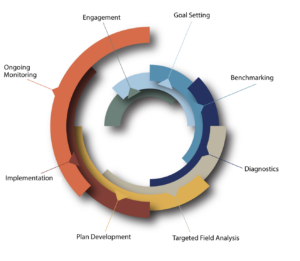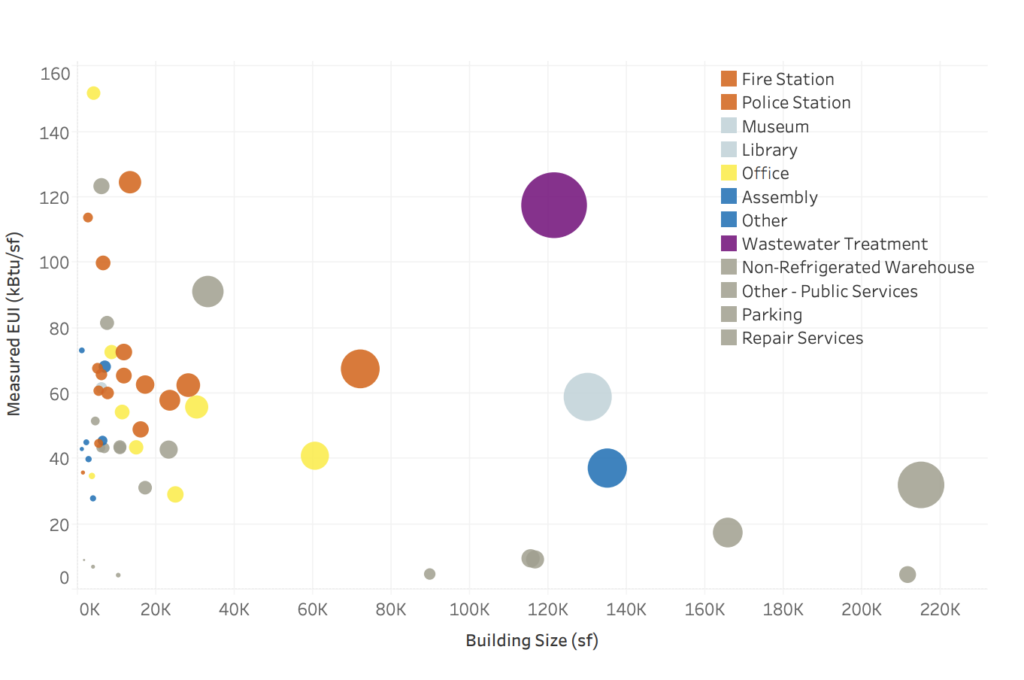Hundreds of cities across the country have set bold, aggressive energy and climate goals. Yet most of these communities are not on track to meet their goals, according to the latest City Clean Energy Scorecard, released in July by American Council for an Energy Efficient Economy. That said, there are plenty of examples of cities, local government agencies and states that are stepping up to make great improvements, and New Buildings Institute (NBI) has resources to help.
Leading cities across North America have taken steps to improve energy performance of buildings, typically starting with publicly owned buildings. As buildings account for 39% of carbon emissions nationally and up to 75% in some cities, climate action requires strategies to address the built environment. Large cities often have staff members dedicated to this work, but small- and medium-sized cities frequently lack the staff resources and bandwidth to tackle comprehensive energy efficiency focused assessments of their portfolio of public buildings, let alone strategically prioritize energy upgrades.
The Public Buildings Portfolio Management Implementation Guide, created by New Buildings Institute (NBI) and partners EcoEdge and Maalka, is a free resource for cities, states, counties, school districts and other community organizations working to reduce the energy use of their public buildings. It describes the whole process of building benchmarking in detail and provides links to helpful resources. We developed the implementation guide, a State and Local Government Toolkit, and an integrated set of open-source tools to make it easier for states and local governments to connect the dots between policy goals and day-to-day operations in a cost-effective and impactful manner.
Putting policy into practice
 Building benchmarking is the practice of measuring and tracking energy and water consumption, as well as carbon and other greenhouse gas emissions, of one building or a portfolio of buildings. Tracking this kind of information is foundational to success when working to reduce building operating expenses and make measurable progress toward energy and climate goals. Benchmarking building performance is becoming increasingly common, with 40% of U.S. commercial building space benchmarked with ENERGY STAR Portfolio Manager®–by far the most common platform.
Building benchmarking is the practice of measuring and tracking energy and water consumption, as well as carbon and other greenhouse gas emissions, of one building or a portfolio of buildings. Tracking this kind of information is foundational to success when working to reduce building operating expenses and make measurable progress toward energy and climate goals. Benchmarking building performance is becoming increasingly common, with 40% of U.S. commercial building space benchmarked with ENERGY STAR Portfolio Manager®–by far the most common platform.
Simply keeping track of energy usage information is no guarantee of energy and emission reductions. It is critical to find ways to transform benchmarking data into actions, such as generating a strategic facilities plan. An organization’s success depends on a variety of factors, many of which we were able to learn about firsthand during two overlapping Public Buildings Portfolio Management Initiative projects funded by the Northwest Energy Efficiency Alliance and others.
Building benchmarking: lessons from the field
Over the last five years, we worked with a group of medium-sized cities around the country, including Boise, Cambridge, Eugene, Grand Rapids, Missoula, Pittsburgh, Providence, and Tacoma, to develop and refine the Public Buildings Portfolio Management process and related free tools and resources. We worked with these cities to leverage energy data and implement long-term, strategic plans to help them meet their energy and emission reduction goals. Following are a few key takeaways.
-
- Empower your energy champion. Public buildings portfolio management is a long-term, strategic approach to energy efficiency in public buildings. It requires commitment from city staff, and it is critical to have an energy champion who will oversee the process. Ideally, that person would be a paid staff member with support from other city staff and/or volunteers. They should have the power to make key decisions.
- Foster good relationships with your local utilities. Local utilities have the ability to provide government agencies with energy use data for all buildings. The data delivery methods vary, from paper bills sent to the Finance Department (a challenge to analyze) to compiled spreadsheets with historical data extracts (easier to analyze), to automated (API) data transfers directly from the utility to ENERGY STAR Portfolio Manager (easiest to analyze). Many utilities even commit to helping cities with ongoing benchmarking and identifying energy-saving opportunities.
- Be patient. Energy portfolio management takes time and requires a long-term commitment. It typically takes a year for a medium-sized city to complete benchmarking, another year to leverage that data for a strategic facilities plan, and up to five years to see results.
- Get buy-in from facilities managers and executives. One way to do this is to create customized energy performance reports for each city department, which allows the fire department, for example, to see how its buildings are performing, and influences capital improvement decisions in the future. In Grand Rapids, where energy data for all city-owned buildings is tracked in ENERGY STAR Portfolio Manager, the sustainability director has used this type of personalized reporting to increase buy-in among decision makers.

Energy Use Intensity, Size, and Total Energy Use of Buildings in City Portfolio: This bubble chart shows three building performance characteristics for each building. Larger buildings are to the right side of the figure (x-axis), and more energy-intensive buildings are farther up on the figure (y-axis). The size of each bubble indicates its total energy consumption: buildings with larger bubbles, such as the wastewater treatment plant (purple), have higher energy consumption.
We shared more lessons learned from our experience working with cities on the Public Buildings Portfolio Management Initiative in a free, on-demand webinar that was recorded on September 12, 2019.
NBI and our partners are available to assist cities, states, special districts and other public agencies committed to putting their policy goals into action. We support cities and other governments by gathering and analyzing building energy use data, drafting and implementing strategic plans, helping plan and implement ongoing monitoring processes, and communicating outcomes and impacts to stakeholders.
For more information, contact Alexi Miller, NBI senior program manager, by email to learn more.
